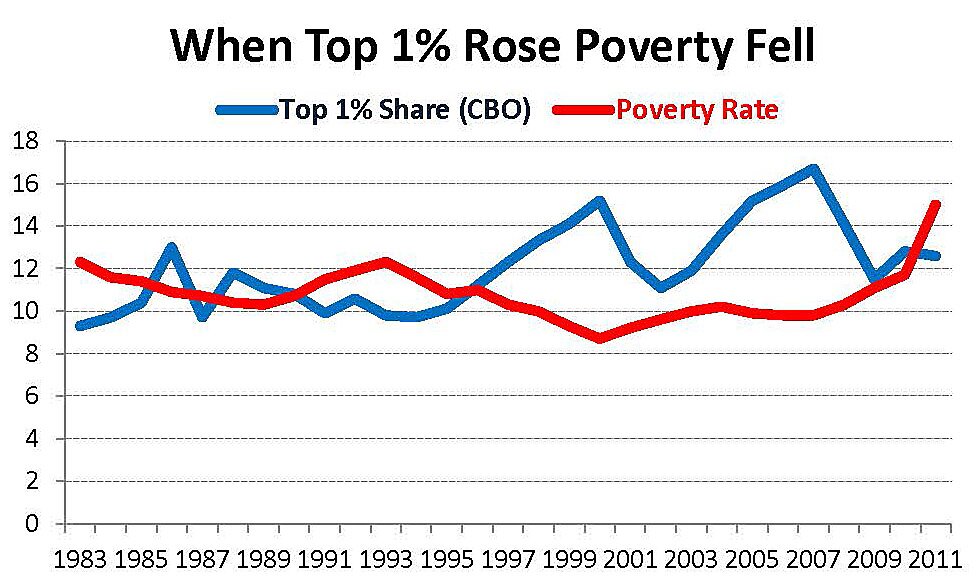Jim Tankersley of the Washington Post believes he has discovered “The Big Issue With Hillary Clinton Running Against Inequality”:
“Inequality got worse under Bill Clinton, not better. That’s true if you look at the share of American incomes going to the 1 percent, per economists Emmanuel Saez and Thomas Piketty. It’s also true when you look at the share of American wealth going to the super-super-rich, the top 0.1%, per research by Saez and Gabriel Zucman.”
What this actually reveals is the absurdity of (1) defining inequality solely by top 1% shares of pretax income less government benefits, and (2) judging any strong economic expansion as a failure because top 1% income shares always rise during strong economic expansions.
The graph uses the Congressional Budget Office estimates of top 1% shares, because (unlike Piketty and Saez) they include government benefits as income and subtract federal taxes. What it shows is that both affluence and poverty are normally highly cyclical. When the top 1 percent’s share of after-tax income jumped from 11.2% in 1996 to 15.2% in 2000, the poverty rate simultaneously dropped from 11% to 8.7%. Meanwhile, median income, after taxes and benefits, rose from $50,900 in 1993 to $61,400 by 2001, measured in 2011 dollars.
Conversely, when the top 1% share fell from 16.7% in 2007 to about 12% in 2013 (my estimate), the poverty rate rose from 9.8% to 15%. If we adopt the egalitarians’ top 1% mantra, must we conclude that inequality “got better” lately as poverty got worse?
The income peak of 2000 is a tough act to beat, and few of us are ahead of it today — least of all the top 1%. The brief surge in top incomes of 2006–2007, like the related speculative surge in housing prices, proved unhealthy and unsustainable. But weak economic performance and high poverty in the past four years is no reason to dismiss the 3.7% average economic growth of 1983–2000 simply because such prolonged prosperity made more people rich.
Tankersley also asks us to “look at the share of American wealth going to the super-super-rich, the top 0.1%, per research by Saez and Gabriel Zucman.” As I’ve explained in The Wall Street Journal, however, the Saez-Zucman estimates misinterpret shrinking shares of capital gains and investment income still reported on individual tax returns, or shifted from the corporate tax to a pass-through firm, rather than (like most middle-class savings) sheltered in IRA, 529 and 401(k) plans.
It is easy to envision Republican partisans welcoming and adopting the Tankersley theme that Hillary Clinton should now be ashamed of the strong economy of 1996–2000 because “inequality got worse” as many new firms were created and stock prices soared. Yet whenever stocks crashed and the top 1% share fell (making inequality “better”?) the poverty rate rose and median incomes were flat or down.
Some Republican candidates have already alluded to the same pretax, pre-transfer “top 1%” figures to claim inequality worsened under Obama — meaning since 2009. According to Piketty and Saez, real average incomes of the top 1% were indeed higher in 2013 ($1,119,315) than in the crash of 2009 ($975,884). Before crashing below $1 million in 2009, though, top 1% incomes had been much higher in 2007 (the equivalent of $1,533, 064 in 2013 dollars) and in 2000 ($1,369,780). The rising tide has not lifted many small boats or big yachts since 2009, because the tide hasn’t risen much; higher tax rates in 2013 certainly didn’t help.
The trouble with Republicans using highly cyclical top 1% statistics as a political weapon against Democrats is that doing so requires capitulating to the divisive and dishonest leftist fallacy that poor people and middle-income people do best when the top 1% is doing badly.
The truth is that the poverty rate fell sharply and middle-incomes rose briskly in President Clinton’s second term, and the top 1% gladly reported more taxable income and paid more taxes as the tax on capital gains was cut from 28% to 20%. There is a lesson to be learned here, but it is not to denigrate the so-called rising inequality of the late 1990s.

